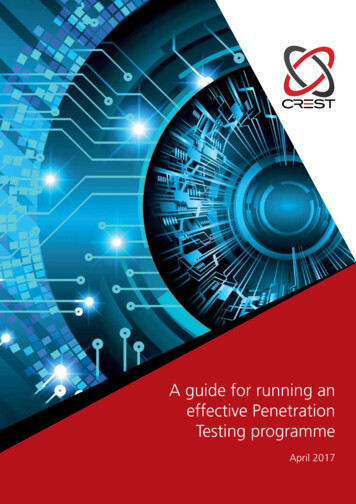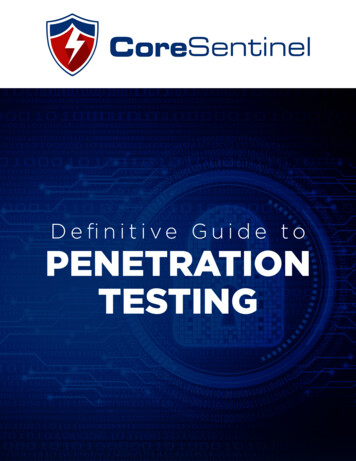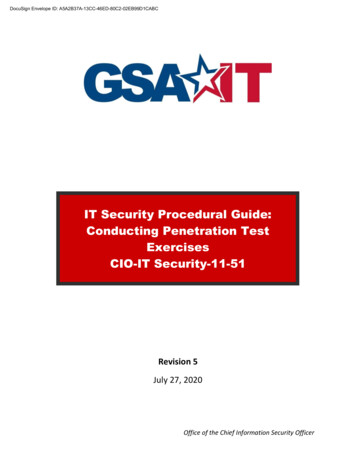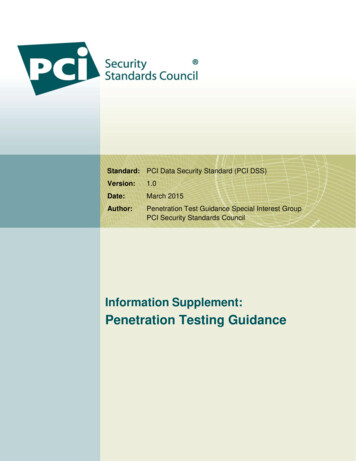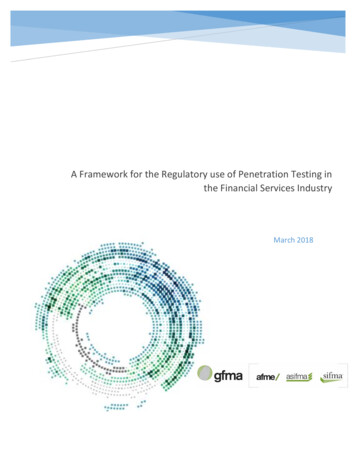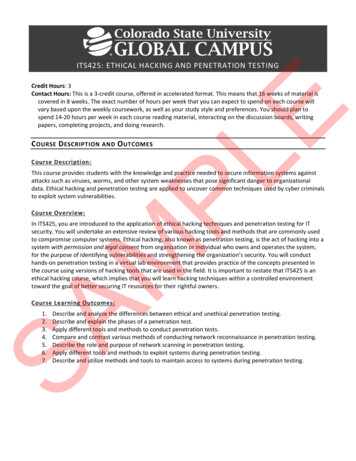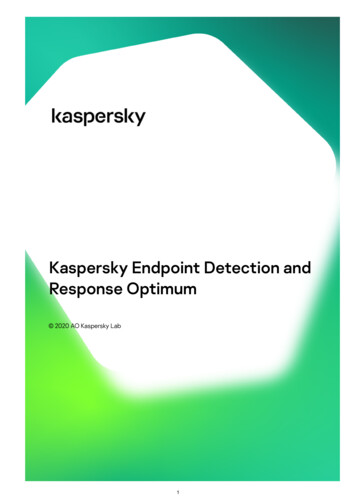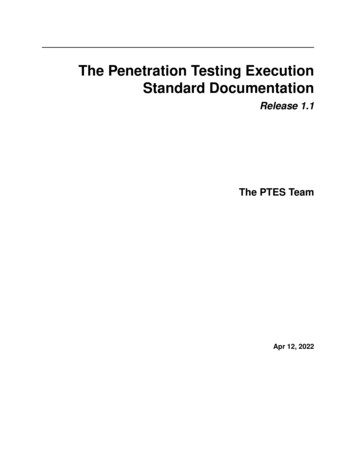
Transcription
The Penetration Testing ExecutionStandard DocumentationRelease 1.1The PTES TeamApr 12, 2022
Contents1The Penetration Testing Execution Standard1.1 High Level Organization of the Standard . . . . . . . . . . . . . . . . . . . . . . . . . . . . . . . .2Pre-engagement Interactions2.1 Overview . . . . . . . . . . . . . . . . . . . .2.2 Introduction to Scope . . . . . . . . . . . . .2.3 Metrics for Time Estimation . . . . . . . . . .2.4 Scoping Meeting . . . . . . . . . . . . . . . .2.5 Additional Support Based on Hourly Rate . . .2.6 Questionnaires . . . . . . . . . . . . . . . . .2.7 General Questions . . . . . . . . . . . . . . .2.8 Scope Creep . . . . . . . . . . . . . . . . . .2.9 Specify Start and End Dates . . . . . . . . . .2.10 Specify IP Ranges and Domains . . . . . . . .2.11 Dealing with Third Parties . . . . . . . . . . .2.12 Define Acceptable Social Engineering Pretexts2.13 DoS Testing . . . . . . . . . . . . . . . . . .2.14 Payment Terms . . . . . . . . . . . . . . . . .2.15 Goals . . . . . . . . . . . . . . . . . . . . . .2.16 Establish Lines of Communication . . . . . .2.17 Emergency Contact Information . . . . . . . .2.18 Rules of Engagement . . . . . . . . . . . . . .2.19 Capabilities and Technology in Place . . . . .55566777101011111212121314141618Intelligence Gathering3.1 General . . . . . . . . . . . . .3.2 Intelligence Gathering . . . . .3.3 Target Selection . . . . . . . .3.4 OSINT . . . . . . . . . . . . .3.5 Covert Gathering . . . . . . . .3.6 Footprinting . . . . . . . . . .3.7 Identify Protection Mechanisms.1919202021303135Threat Modeling4.1 General . . . . . . . . . . . . . . . . . . . . . . . . . . . . . . . . . . . . . . . . . . . . . . . . . .4.2 Business Asset Analysis . . . . . . . . . . . . . . . . . . . . . . . . . . . . . . . . . . . . . . . . .4.3 Business Process Analysis . . . . . . . . . . . . . . . . . . . . . . . . . . . . . . . . . . . . . . . .3737384134.33i
4.44.54.64.756789Vulnerability Analysis5.1 Testing . . . . .5.2 Active . . . . . .5.3 Passive . . . . .5.4 Validation . . . .5.5 Research . . . .41424343.454545494951Exploitation6.1 Purpose . . . . . . . . . . . . . .6.2 Countermeasures . . . . . . . . .6.3 Evasion . . . . . . . . . . . . . .6.4 Precision Strike . . . . . . . . . .6.5 Customized Exploitation Avenue6.6 Tailored Exploits . . . . . . . . .6.7 Zero-Day Angle . . . . . . . . .6.8 Example Avenues of Attack . . .6.9 Overall Objective . . . . . . . . .53535355555556565859Post Exploitation7.1 Purpose . . . . . . . . . . . . . . . .7.2 Rules of Engagement . . . . . . . . .7.3 Infrastructure Analysis . . . . . . . .7.4 Pillaging . . . . . . . . . . . . . . .7.5 High Value/Profile Targets . . . . . .7.6 Data Exfiltration . . . . . . . . . . .7.7 Persistence . . . . . . . . . . . . . .7.8 Further Penetration Into Infrastructure7.9 Cleanup . . . . . . . . . . . . . . . .61616163657272737374Reporting8.1 Overview . . . . . . . .8.2 Report Structure . . . .8.3 The Executive Summary8.4 Technical Report . . . .7575757577PTES Technical Guidelines9.1 Tools Required . . . . .9.2 Intelligence Gathering .9.3 Vulnerability Analysis .9.4 Exploitation . . . . . .9.5 Post Exploitation . . . .9.6 Reporting . . . . . . . .9.7 Custom tools developed9.8 Appendix . . . . . . . .818184131154180190193193Q: What is this “Penetration Testing Execution Standard”?Q: Who is involved with this standard? . . . . . . . . . .Q: So is this a closed group or can I join in? . . . . . . . .Q: Is this going to be a formal standard? . . . . . . . . .22522522522622610 FAQ10.110.210.310.4iiThreat Agents/Community Analysis . . . . . . . . . . . . . . . . . . .Threat Capability Analysis . . . . . . . . . . . . . . . . . . . . . . . .Motivation Modeling . . . . . . . . . . . . . . . . . . . . . . . . . . .Finding relevant news of comparable Organizations being compromised.
10.510.610.710.8Q: Is the standard going to include all possible pentest scenarios?Q: Is this effort going to standardize the reporting as well? . . . .Q: Who is the intended audience for this standard/project? . . . .Q: Is there a mindmap version of the original sections? . . . . . .22622622622711 Media22912 Indices and tables231iii
iv
The Penetration Testing Execution Standard Documentation, Release 1.1Contents:Contents1
The Penetration Testing Execution Standard Documentation, Release 1.12Contents
CHAPTER1The Penetration Testing Execution Standard1.1 High Level Organization of the StandardFork Disclaimer: Note that this is an unofficial fork, the goal for which is to experiment with an alternative platformfor the standard. The official PTES can be located at http://pentest-standard.org/.The penetration testing execution standard consists of seven (7) main sections. These cover everything related to apenetration test - from the initial communication and reasoning behind a pentest, through the intelligence gatheringand threat modeling phases where testers are working behind the scenes in order to get a better understanding of thetested organization, through vulnerability research, exploitation and post exploitation, where the technical securityexpertise of the testers come to play and combine with the business understanding of the engagement, and finally tothe reporting, which captures the entire process, in a manner that makes sense to the customer and provides the mostvalue to it.This version can be considered a v1.0 as the core elements of the standard are solidified, and have been “road tested”for over a year through the industry. A v2.0 is in the works soon, and will provide more granular work in terms of“levels” - as in intensity levels at which each of the elements of a penetration test can be performed at. As no pentestis like another, and testing will range from the more mundane web application or network test, to a full-on red teamengagement, said levels will enable an organization to define how much sophistication they expect their adversary toexhibit, and enable the tester to step up the intensity on those areas where the organization needs them the most. Someof the initial work on “levels” can be seen in the intelligence gathering section.Following are the main sections defined by the standard as the basis for penetration testing execution:1. Pre-engagement Interactions2. Intelligence Gathering3. Threat Modeling4. Vulnerability Analysis5. Exploitation6. Post Exploitation7. Reporting3
The Penetration Testing Execution Standard Documentation, Release 1.1As the standard does not provide any technical guidelines as far as how to execute an actual pentest, we have alsocreated a technical guide to accompany the standard itself. The technical gude can be reached via the link below: PTES Technical GuidelinesFor more information on what this standard is, please visit: FAQ4Chapter 1. The Penetration Testing Execution Standard
CHAPTER2Pre-engagement Interactions2.1 OverviewThe aim of this section of the PTES is to present and explain the tools and techniques available which aid in asuccessful pre-engagement step of a penetration test. The information within this section is the result of the manyyears of combined experience of some of the most successful penetration testers in the world.If you are a customer looking for penetration test we strongly recommend going to the General Questions section ofthis document. It covers the major questions that should be answered before a test begins. Remember, a penetrationtest should not be confrontational. It should not be an activity to see if the tester can “hack” you. It should be aboutidentifying the business risk associated with and attack.To get maximum value, make sure the questions in this document are covered. Further, as the Scoping activityprogresses, a good testing firm will start to ask additional questions tailored to your organization.2.2 Introduction to ScopeDefining scope is arguably one of the most important components of a penetration test, yet it is also one of the mostoverlooked. While many volumes have been written about the different tools and techniques which can be utilizedto gain access to a network, very little has been written on the topic which precedes the penetration: preparation.Neglecting to properly complete pre-engagement activities has the potential to open the penetration tester (or his firm)to a number of headaches including scope creep, unsatisfied customers, and even legal troubles. The scope of a projectspecifically defines what is to be tested. How each aspect of the test will be conducted will be covered in the Rules ofEngagement section.One key component of scoping an engagement is outlining how the testers should spend their time. As an example, acustomer requests that one hundred IP addresses be tested for the price of 100,000. This means that the customer isoffering 1,000 per IP address tested. However, this cost structure only remains effective at that volume. A commontrap some testers fall into is maintaining linear costs throughout the testing process. If the customer had only asked forone business-critical application to be tested at the same pricing structure ( 1,000), while the tester will still be onlyattacking a single IP, the volume of work has increased dramatically. It is important to vary costs based on work done.5
The Penetration Testing Execution Standard Documentation, Release 1.1Otherwise a firm can easily find themselves undercharging for their services, which motivates them to do a less thancomplete job.Despite having a solid pricing structure, the process is not all black and white. It is not uncommon for a client tobe completely unaware of exactly what it is they need tested. It is also possible the client will not know how tocommunicate effectively what they’re expecting from the test. It is important in the Pre-Engagement phase that thetester is able to serve as a guide through what may be uncharted territory for a customer. The tester must understandthe difference between a test which focuses on a single application with severe intensity and a test where the clientprovides a wide range of IP addresses to test and the goal is to simply find a way in.2.3 Metrics for Time EstimationTime estimations are directly tied to the experience of a tester in a certain area. If a tester has significant experiencein a certain test, he will likely innately be able to determine how long a test will take. If the tester has less experiencein the area, re-reading emails and scan logs from previous similar tests the firm has done is a great way to estimate thetime requirement for the current engagement. Once the time to test is determined, it is a prudent practice to add 20%to the time.The extra 20% on the back end of the time value is called padding. Outside of consultant circles, this is also referred toas consultant overhead. The padding is an absolute necessity for any test. It provides a cushion should any interruptionsoccur in the testing. There are many events which commonly occur and hinder the testing process. For example, anetwork segment may go down, or a significant vulnerability may be found which requires many meetings with manylevels of management to address. Both of these events are time consuming and would significantly impact the originaltime estimate if the padding was not in place.What happens if the 20% padding ends up not being necessary? Billing the client for time not worked would beextremely unethical, so it is up to the testers to provide additional value that may not normally have been provided ifthe engagement time limit had been hit. Examples include walking the company security team through the steps takento exploit the vulnerability, provide an executive summary if it was not part of the original deliverable list, or spendsome additional time trying to crack a vulnerability that was elusive during the initial testing.Another component of the metrics of time and testing is that every project needs to have a definitive drop dead date.All good projects have a well-defined beginning and end. You will need to have a signed statement of work specifyingthe work and the hours required if you’ve reached the specific date the testing is to end, or if any additional testing orwork is requested of you after that date. Some testers have a difficult time doing this because they feel they are beingtoo much of a pain when it comes to cost and hours. However, it has been the experience of the author that if youprovide exceptional value for the main test the customer will not balk at paying you for additional work.2.4 Scoping MeetingIn many cases the scoping meeting will occur after the contract has been signed. Situations do occur wherein many ofthe scope-related topics can be discussed before contract signing, but they are few and far between. For those situationsit is recommended that a non-disclosure agreement be signed before any in-depth scoping discussions occur.The goal of the scoping meeting is to discuss what will be tested. Rules of engagement and costs will not be covered inthis meeting. Each of these subjects should be handled in meetings where each piece is the focus of that meeting. Thisis done because discussions can easily become confused and muddled if focus is not explicitly stated. It is importantto act as moderator and keep the discussions on-topic, preventing tangents and declaring certain topics more suited foroff-line discussion when necessary.Now that a Rough Order of Magnitude (ROM) value has been established for the project it is time to have a meetingwith the customer to validate assumptions. First, it needs to be established explicitly what IP ranges are in scope for theengagement. It is not uncommon for a client to be resistant and assume that it is the prerogative of the tester to identifytheir network and attack it, to make the test as realistic as possible. This would indeed be an ideal circumstance,6Chapter 2. Pre-engagement Interactions
The Penetration Testing Execution Standard Documentation, Release 1.1however, possible legal ramifications must be considered above all else. Because of this, it is the responsibility of thetester to convey to a client these concerns and to impart upon them the importance of implicit scoping. For example,in the meeting, it should be verified that the customer owns all of the target environments including: the DNS server,the email server, the actual hardware their web servers run on and their firewall/IDS/IPS solution. There are a numberof companies which will outsource the management of these devices to third parties.Additionally, the countries, provinces, and states in which the target environments operate in must be identified. Lawsvary from region to region and the testing may very well be impacted by these laws. For instance, countries belongingto the European Union are well known to have very stringent laws surrounding the privacy of individuals, which cansignificantly change the manner in which a social engineering engagement would be executed.2.5 Additional Support Based on Hourly RateAnything that is not explicitly covered within the scope of the engagement should be handled very carefully. The firstreason for this is scope creep. As the scope expands, resources are consumed, cutting into the profits for the tester andmay even create confusion and anger on the part of the customer. There is another issue that many testers do not thinkof when taking on additional work on an ad-hoc basis: legal ramifications. Many ad-hoc requests are not properlydocumented so it can be difficult to determine who said what in the event of a dispute or legal action. Further, thecontract is a legal document specifying the work that is to be done. It should be tightly tied to the permission to testmemo.Any requests outside of the original scope should be documented in the form of a statement of work that clearlyidentifies the work to be done. We also recommend that it be clearly stated in the contract that additional workwill be done for a flat fee per hour and explicitly state that additional work can not be completed until a signed andcounter-signed SOW is in place.2.6 QuestionnairesDuring initial communications with the customer there are several questions which the client will have to answer inorder for the engagement scope can be properly estimated. These questions are designed to provide a better understanding of what the client is looking to gain out of the penetration test, why the client is looking to have a penetrationtest performed against their environment, and whether or not they want certain types of tests performed during thepenetration test. The following are sample questions which may be asked during this phase.2.7 General Questions2.7.1 Network Penetration Test1. Why is the customer having the penetration test performed against their environment?2. Is the penetration test required for a specific compliance requirement?3. When does the customer want the active portions (scanning, enumeration, exploitation, etc. . . ) of the penetrationtest conducted?1. During business hours?2. After business hours?3. On the weekends?4. How many total IP addresses are being tested?2.5. Additional Support Based on Hourly Rate7
The Penetration Testing Execution Standard Documentation, Release 1.11. How many internal IP addresses, if applicable?2. How many external IP addresses, if applicable?5. Are there any devices in place that may impact the results of a penetration test such as a firewall, intrusiondetection/prevention system, web application firewall, or load balancer?6. In the case that a system is penetrated, how should the testing team proceed?1. Perform a local vulnerability assessment on the compromised machine?2. Attempt to gain the highest privileges (root on Unix machines, SYSTEM or Administrator on Windowsmachines) on the compromised machine?3. Perform no, minimal, dictionary, or exhaustive password attacks against local password hashes obtained(for example, /etc/shadow on Unix machines)?2.7.2 Web Application Penetration Test1. How many web applications are being assessed?2. How many login systems are being assessed?3. How many static pages are being assessed? (approximate)4. How many dynamic pages are being assessed? (approximate)5. Will the source code be made readily available?6. Will there be any kind of documentation?1. If yes, what kind of documentation?7. Will static analysis be performed on this application?8. Does the client want fuzzing performed against this application?9. Does the client want role-based testing performed against this application?10. Does the client want credentialed scans of web applications performed?2.7.3 Wireless Network Penetration Test1. How many wireless networks are in place?2. Is a guest wireless network used? If so:1. Does the guest network require authentication?2. What type of encryption is used on the wireless networks?3. What is the square footage of coverage?4. Will enumeration of rogue devices be necessary?5. Will the team be assessing wireless attacks against clients?6. Approximately how many clients will be using the wireless network?8Chapter 2. Pre-engagement Interactions
The Penetration Testing Execution Standard Documentation, Release 1.12.7.4 Physical Penetration Test1. How many locations are being assessed?2. Is this physical location a shared facility? If so:1. How many floors are in scope?2. Which floors are in scope?3. Are there any security guards that will need to be bypassed? If so:1. Are the security guards employed through a 3rd party?2. Are they armed?3. Are they allowed to use force?4. How many entrances are there into the building?5. Is the use of lock picks or bump keys allowed? (also consider local laws)6. Is the purpose of this test to verify compliance with existing policies and procedures or for performing an audit?7. What is the square footage of the area in scope?8. Are all physical security measures documented?9. Are video cameras being used?1. Are the cameras client-owned? If so:1. Should the team attempt to gain access to where the video camera data is stored?10. Is there an armed alarm system being used? If so:1. Is the alarm a silent alarm?2. Is the alarm triggered by motion?3. Is the alarm triggered by opening of doors and windows?2.7.5 Social Engineering1. Does the client have a list of email addresses they would like a Social Engineering attack to be performedagainst?2. Does the client have a list of phone numbers they would like a Social Engineering attack to be performedagainst?3. Is Social Engineering for the purpose of gaining unauthorized physical access approved? If so:1. How many people will be targeted?It should be noted that as part of different levels of testing, the questions for Business Unit Managers, Systems Administrators, and Help Desk Personnel may not be required. However, in the case these questions are necessary, somesample questions can be found below.2.7.6 Questions for Business Unit Managers1. Is the manager aware that a test is about to be performed?2. What is the main datum that would create the greatest risk to the organization if exposed, corrupted, or deleted?3. Are testing and validation procedures to verify that business applications are functioning properly in place?2.7. General Questions9
The Penetration Testing Execution Standard Documentation, Release 1.14. Will the testers have access to the Quality Assurance testing procedures from when the application was firstdeveloped?5. Are Disaster Recovery Procedures in place for the application data?2.7.7 Questions for Systems Administrators1. Are there any systems which could be characterized as fragile? (systems with tendencies to crash, older operating systems, or which are unpatched)2. Are there systems on the network which the client does not own, that may require additional approval to test?3. Are Change Management procedures in place?4. What is the mean time to repair systems outages?5. Is any system monitoring software in place?6. What are the most critical servers and applications?7. Are backups tested on a regular basis?8. When was the last time the backups were restored?2.8 Scope CreepScope creep is one of the most efficient ways to put a penetration testing firm out of business. The issue is that manycompanies and managers have little to no idea how to identify it, or how to react to it when it happens.There are a couple of things to remember when battling scope creep. First, if a customer is pleased with the work doneon a particular engagement, it is very common for them to request additional work. Take this as a compliment, and donot hesitate to ask for additional funding to compensate for the extra time spent. If a customer refuses to pay for theextra work, it is almost never worth staying on to do that work.The second point is even more critical. When dealing with existing customers, take care to keep the prices lower. Taking advantage of a good situation by price gouging is a sure way to drive away repeat business. Take into considerationthat prices can be lowered since the firm avoided the costs of acquiring the customer such as the formal RFP processand hunting for the customer itself. Further, the best source for future work is through existing customers. Treat themwell and they will return.2.9 Specify Start and End DatesAnother key component defeating scope creep is explicitly stating start and end dates. This allows the project to havedefinite end. One of the most common areas in which scope creep occurs is during retesting. Retesting always soundslike a good idea when going after a contract. It shows that the firm is caring and diligent, trying to make ensure thatthe customer is secure as possible. The problem begins when it is forgotten that the work is not paid for until it iscompleted. This includes retesting.To mitigate this risk, add a simple statement to the contract which mentions that all retesting must be done withina certain timeframe after the final report delivery. It then becomes the responsibility of the testers to spearhead theretesting effort. If the customer requests an extension, always allow this with the condition that payment be fulfilledat the originally specified date. Finally, and most importantly, perform a quality retest. Remember, the best source forfuture work is your existing customer base.10Chapter 2. Pre-engagement Interactions
The Penetration Testing Execution Standard Documentation, Release 1.12.10 Specify IP Ranges and DomainsBefore starting a penetration test, all targets must be identified. These targets should be obtained from the customerduring the initial questionnaire phase. Targets can be given in the form of specific IP addresses, network ranges, ordomain names by the customer. In some instances, the only target the customer provides is the name of the organizationand expects the testers be able to identify the rest on their own. It is important to define if systems like firewalls andIDS/IPS or networking equipment that are between the tester and the final target are also part of the scope. Additionalelements such as upstream providers, and other 3rd party providers should be identified and defined whether they arein scope or not.2.10.1 Validate RangesIt is imperative that before you start to attack the targets you validate that they are in fact owned by the customer youare performing the test against. Think of the legal consequences you may run into if you start attacking a machine andsuccessfully penetrate it only to find out later down the line that the machine actually belongs to another organization(such as a hospital or government agency).2.11 Dealing with Third PartiesThere are a number of situations where an engagement will include testing a service or an application that is beinghosted by a third party. This has become more prevalent in recent years as “cloud” services have become more popular.The most important thing to remember is that while permission may have been granted by the client, they do not speakfor their third party providers. Thus, permission must be obtained from them as well in order to test the hosted systems.Failing to obtain the proper permissions brings with it, as always, the possibility of violating the law, which can causeendless headaches.2.11.1 Cloud ServicesThe single biggest issue with testing cloud service is there is data from multiple different organizations stored on onephysical medium. Often the security between these different data domains is very lax. The cloud services providerneeds to be alerted to the testing and needs to acknowledge that the test is occurring and grant the testing organizationpermission to test. Further, there needs to be a direct security contact within the cloud service provider that can becontacted in the event that a security vulnerability is discovered which may impact the other cloud customers. Somecloud providers have specific procedures for penetration testers to follow, and may require request forms, schedulingor explicit permission from them before testing can begin.2.11.2 ISPVerify the ISP terms of service with the customer. In many commercial situations the ISP will have specific provisionsfor testing. Review these terms carefully before launching an attack. There are situations where ISPs will shun andblock certain traffic which is considered malicious. The customer may approve this risk, but it must always be clearlycommunicated before beginning.2.11.3 Web HostingAs with all other third parties, the scope and timing of the test needs to be clearly communicated with the we
of the initial work on “levels” can be seen in the intelligence gathering section. Following are the main sections defined by the standard as the basis for penetration testing execution: 1. Pre-engagement Interactions 2. Intelligence Gathering 3. Threat Modeling 4. Vulnerability Ana
